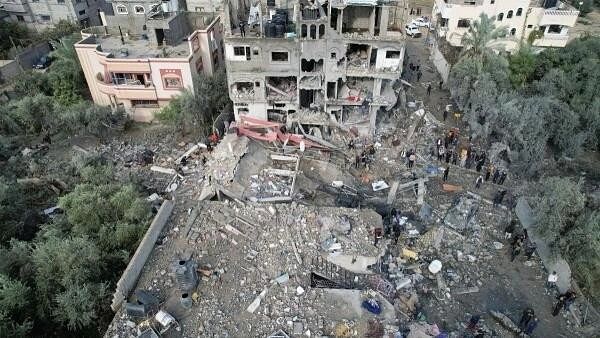
Palestinians gather at the site of Israeli strikes on houses, amid the ongoing conflict between Israel and the Palestinian Islamist group Hamas, at the Maghazi camp in the central Gaza Strip.
Credit: Reuters Photo
Jerusalem: Before October 7, Hana Cooper downloaded everything from daily news reports to rabbinic blog posts, saving them for posterity in the Israeli National Library's archive of the Israeli internet and the broader Jewish online world.
But within days of the Hamas-led attacks, Cooper began spending her time archiving violent images of the assault, many of them posted by the attackers themselves on digital platforms like Telegram.
"It was surreal," Cooper said in an interview. "I was working with the same tools, but in a completely different world. The war became everything that I did."
Israel's cultural sector had to reconstitute itself on October 7, as the nation grieved the roughly 1,200 people killed that day and the military called up hundreds of thousands of citizens.
With rockets from the Gaza Strip flying overhead, museums activated emergency protocols, swiftly moving priceless paintings and historical treasures, like the Dead Sea Scrolls, to underground vaults. Cinemas and theaters were shut, in line with the somber national mood.
The National Library in Jerusalem, which had planned to inaugurate a new $225 million building on October 17, seemed likely to become another shuttered cultural institution.
The structure, a long, limestone building designed by the Swiss firm Herzog & de Meuron that took nearly 10 years to construct, sits in the city's administrative and cultural heart, among the Supreme Court, Hebrew University, the Israel Museum and several government ministries. The library's curved glass roof, which lets natural light into the large reading room, was designed so as not to obstruct views of the Knesset, Israel's parliament.
Soon after the October 7 attack, foreign construction teams still making last-minute adjustments were evacuated from Israel. The opening ceremony was canceled. The builders left bolts and panels lying in the building's rounded, softly lit walkways.
The library nevertheless decided to open the building and has been welcoming patrons since October 29. "When the cannons are heard, the muses will not be silent," said Sallai Meridor, chair of the library's board of directors, playing on a Soviet expression.
In part, they hope to create an island of sanity in a disrupted nation. "The library has been able to play a tremendously therapeutic role," said Raquel Ukeles, head of collections at the library. She said that many visitors have been evacuees from the country's borders with Gaza and Lebanon, where communities are regularly targeted with rockets and shells, or reservists on leave from the Israeli military.
The library has helped stock mobile libraries that travel the country. Its staff members have also assisted in setting up a "pop-up" school in the previous National Library building for roughly 100 children displaced from their homes by fighting along the Lebanese border.
In the library's reading room stand scores of chairs, each one holding a book chosen to represent one of the hostages taken on October 7.
For little Avigail Idan, whose parents were killed when attackers overran their home in Kibbutz Kfar Azza and who turned 4 in captivity, the exhibition's curator, Dorit Gani, chose "The Kiss That Went Missing," a popular Israeli children's book. For Gali Tarshansky, a 13-year-old whose dream is to open a shelter for abandoned dogs, Gani chose "Lassie Come-Home." Both girls were freed in late November.
Some hostages' family members and friends have asked Gani to display books that had personal meaning to them. Noam Alon, whose girlfriend, Inbar Heiman, was abducted from the Nova Party music festival, asked that she be represented by "The Art of Loving," by Erich Fromm, which the two had been reading together in the weeks before the attack. On December 16, Heiman was confirmed to have been killed in Hamas captivity.
The library also has found new ways to serve its core mission as a custodian of collective national memory, painful as this new chapter is.
Library workers are salvaging and digitizing local archives from the ravaged communities overrun on October 7 and staffers like Cooper are gathering and archiving WhatsApp conversations, in recognition of their documentary value. In Kibbutz Be'eri, the site of some of the worst atrocities on October 7, one the more reliable logs of the day's events are the messages sent on the community's group chat.
The library's collection team has also offered guidance, expertise and a long-term home to several grassroots documentation efforts. These include a group of doctoral students taking oral testimony from survivors, and tech developers who used artificial intelligence to assess the condition of hostages, sifting through hundreds of hours of video footage.
Ultimately, this growing corpus will be essential in helping Israelis make sense of the moment, according to Ukeles.
"I think the library has become a symbol of hope," she said. "A reminder, in this ongoing nightmare, of what are we here for, and what this society is trying to build."